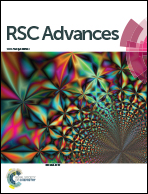Regioregularity effect on the self-assembly behavior of poly(3-hexylthiophene): the significance of triad sequence†
Abstract
Poly(3-hexylthiophene) (P3HT) is one of the most widely studied conjugated polymers for applications in polymer-based photovoltaics and thin-film transistors. The regioregularity index (RR) represented by the mole percentage of the head-to-tail (HT) dyad in the polymer molecule has been considered as a key factor governing both the kinetics and thermodynamics of the self-assembly of P3HT. In this study, we reveal that the configurational sequence beyond dyad plays an equally important role by demonstrating that two P3HT samples bearing almost identical RR value and average molecular weight displayed very different self-assembly kinetics. Counterintuitively, the semidilute xylene solution of the P3HT with slightly smaller RR value exhibited a much faster gelation. In the bulk state, this sample also showed faster crystallization kinetics and higher melting point. Characterization of the configurational structure by nuclear magnetic resonance (NMR) spectroscopy showed that the P3HT with the smaller RR value contained a higher population of HT-HT triad sequence. Therefore, knowledge of this system parameter, which has been omitted prevalently, is essential for the delicate control of the morphological formation of P3HT for enhancing its photophysical properties.


 Please wait while we load your content...
Please wait while we load your content...